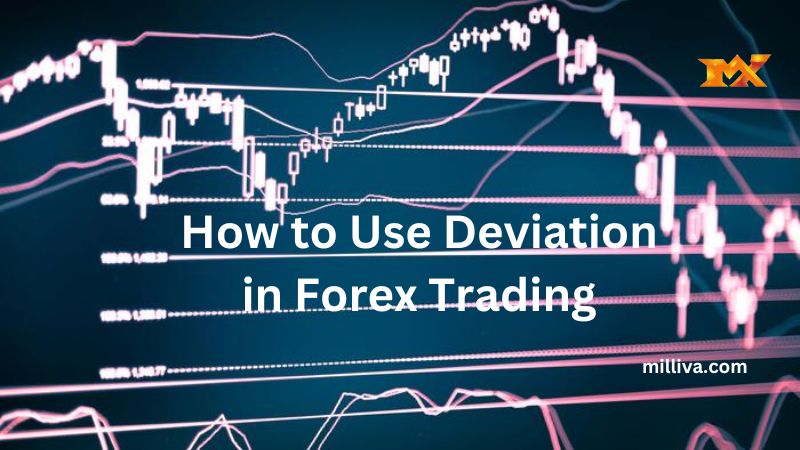Forex Deviation Levels

![]()
For active currency traders, market volatility presents a vast array of opportunities and challenges. Fluctuations in the exchange rates of Forex pairs can occur rapidly and seemingly out of nowhere. One standard mechanism is use by Forex market participants to identify normal and abnormal moves in pricing that is Standard deviation.
Deviation is a statistical device used to measure the distance between a data point and its mean value at a specific time. It is frequently implement in many disciplines like science, technology and finance.
What is Deviation in Forex?
Forex and futures are very different financial instruments, but the ways in which they are trade are very similar. Underpinnings of each market are unique, the application of technical analytics remains relatively constant.
Deviation is one of the more popular technical tools use in Forex trading. If you have any experience in the markets, then you know that a sudden spike in volatility can close out a soon to be profitable trade as a loss. That’s where deviation is most useful it establish the inherent volatility of a currency pair before an order is ever place.
Deviation is a term use in statistics to measure the variance of a dataset from its mean value. Essentially, the further a value falls in relation to its mean, the greater the standard deviation. While we talk about deviation in Forex, its best thought of as volatility measurement. Traders use it to put current price action into context by establishing a periodic closing price’s relation to an average or mean value.
Due to the complexity of calculating standard deviation, doing so manually in a live Forex environment is a nonstarter. Luckily for active traders, most software platforms feature a deviation tool that executes the derivations automatically in real time.
How to Use Deviation in Forex Trading?
Traders need to apply the deviation indicators or any standard deviation indicators to measure price dispersion on the chart, to use deviation in Forex trading. Bar prices are disperse relative to the moving average, when standard deviation is high. The market is more volatile.
How to Apply Deviation in Forex Trading?
In high deviation the event that periodic closing prices are falling far away from an establish mean, deviation is said to be high. This means that pricing volatility is extreme, and the periodic ranges are large. Both risk and potential rewards are greater during periods of high deviation.
Low deviation suggests that periodic closing prices reside near the established mean. Pricing volatility is limit, and a currency pairs is in a consolidation phase. Low deviation often coincides with choppy price action, limited participation, and pending breakouts.
The biggest advantage of using deviation is that it’s an intuitive tool. Once you determine the presence of high or low deviation, you can tailor a trading strategy accordingly. Here are a few common ways that traders use this information.
In high deviation situation, currency pairs exhibiting extreme volatility are prime targets for both reversal and trend following approaches. The wide periodic trading ranges provide ideal risks and reward trade setups.
In low deviation situation, the event volatility is mute, rotational trading strategy are often the best course of action. Breakout trading plans also be suitable, although the risk of false breaks can limit performance.
An important distinct to make regarding standard deviation is that it is design for comparison. Implementing the value in isolation is not especially useful, unless operating within a set of predefined guidelines.
When determining whether a currency or currency pairs is exhibiting low, normal, or high volatility, it is necessary to either calculate the figure for more than one data set, or to reference an accepted benchmark.

Implementing Standard Deviation
Addressing the exchange rate volatilities of currency pairs as they evolve is a key element of active Forex trading. Being able to identify when markets are trending or consolidate is an important skill, and one that is aided greatly used by the deviation indicator.
Forex software trading suites typically feature standard deviation in one or more forms via public domain indicators. There are two commonly use Forex traders they are, Bollinger bands and STDEV.
Bollinger bands are a technical indicator that quantify pricing volatility through the production of upper and lower bands. Standard deviation is a key input in this calculation, as it determine the width of the band.
STDEV is the basic application of the standard deviation statistic upon exchange rate pricing. It is derive by first taking a sample set of price points, then calculating their mean, variance, and deviation. Typically, it is represent as a graphing overlay for easy reference. It provides you with a visual representation of prices dispersion from an established mean value.
Evaluate Volatility by Using Standard Deviation Indicator
Standard deviation in technical term derived from the statics branch in mathematics. It refers to a tool to explain the distribution of particular data set. It evaluates a data value by arranging these values distribution from the data sets mean value.
The higher the standard deviation in Forex, the wider will be the distribution of the data value. The standard deviation in the Forex will be lower, if the standard deviation is much narrower. In the financial market world, the standard deviation is generally used in many ways to determine volatility and risk.
You should care about the volatility because, fund’s managers are highly fascinate with volatility because it is a tool to make more one-one comparison between different funds and their compound returns over a limited time period.
Volatility is also important for long term investors because it helps suggest how to losses may move against you over the long duration investment. In Forex trading, evaluation of the fluctuation of the prices over time is useful for various reasons.
More volatility offers higher profit opportunities, more will be the risk of loss. So the swing traders search for type volatile market because more fluctuation in the market will give a higher profit over a short time period.
Final Thoughts
Deviation is widely accept by active traders as a powerful technical indicator. It is easily interpret in live market conditions and may be automatically applied via the functionality of most software trading platform.
Although manually calculating deviation values is time consuming, modern technology has eliminated the need for any tedious mathematical long-hand. As a result, technical traders from all corners of the Forex market favours tools.

Visit us on: www.milliva.com





